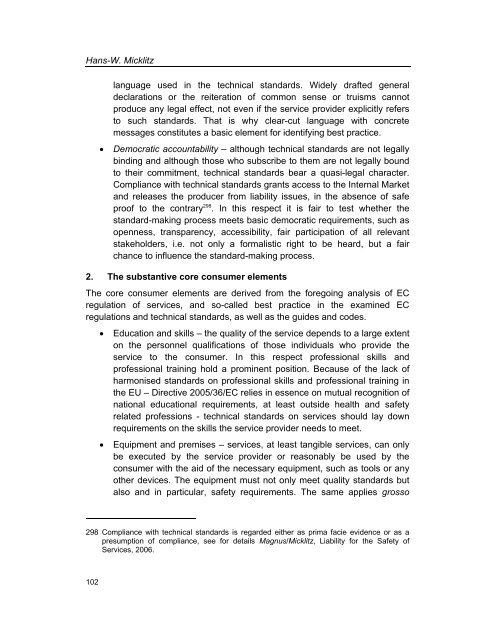Services Standards: Defining the Core Consumer Elements ... - ANEC
Services Standards: Defining the Core Consumer Elements ... - ANEC
Services Standards: Defining the Core Consumer Elements ... - ANEC
You also want an ePaper? Increase the reach of your titles
YUMPU automatically turns print PDFs into web optimized ePapers that Google loves.
Hans-W. Micklitz<br />
language used in <strong>the</strong> technical standards. Widely drafted general<br />
declarations or <strong>the</strong> reiteration of common sense or truisms cannot<br />
produce any legal effect, not even if <strong>the</strong> service provider explicitly refers<br />
to such standards. That is why clear-cut language with concrete<br />
messages constitutes a basic element for identifying best practice.<br />
• Democratic accountability – although technical standards are not legally<br />
binding and although those who subscribe to <strong>the</strong>m are not legally bound<br />
to <strong>the</strong>ir commitment, technical standards bear a quasi-legal character.<br />
Compliance with technical standards grants access to <strong>the</strong> Internal Market<br />
and releases <strong>the</strong> producer from liability issues, in <strong>the</strong> absence of safe<br />
proof to <strong>the</strong> contrary 298 . In this respect it is fair to test whe<strong>the</strong>r <strong>the</strong><br />
standard-making process meets basic democratic requirements, such as<br />
openness, transparency, accessibility, fair participation of all relevant<br />
stakeholders, i.e. not only a formalistic right to be heard, but a fair<br />
chance to influence <strong>the</strong> standard-making process.<br />
2. The substantive core consumer elements<br />
The core consumer elements are derived from <strong>the</strong> foregoing analysis of EC<br />
regulation of services, and so-called best practice in <strong>the</strong> examined EC<br />
regulations and technical standards, as well as <strong>the</strong> guides and codes.<br />
• Education and skills – <strong>the</strong> quality of <strong>the</strong> service depends to a large extent<br />
on <strong>the</strong> personnel qualifications of those individuals who provide <strong>the</strong><br />
service to <strong>the</strong> consumer. In this respect professional skills and<br />
professional training hold a prominent position. Because of <strong>the</strong> lack of<br />
harmonised standards on professional skills and professional training in<br />
<strong>the</strong> EU – Directive 2005/36/EC relies in essence on mutual recognition of<br />
national educational requirements, at least outside health and safety<br />
related professions - technical standards on services should lay down<br />
requirements on <strong>the</strong> skills <strong>the</strong> service provider needs to meet.<br />
• Equipment and premises – services, at least tangible services, can only<br />
be executed by <strong>the</strong> service provider or reasonably be used by <strong>the</strong><br />
consumer with <strong>the</strong> aid of <strong>the</strong> necessary equipment, such as tools or any<br />
o<strong>the</strong>r devices. The equipment must not only meet quality standards but<br />
also and in particular, safety requirements. The same applies grosso<br />
298 Compliance with technical standards is regarded ei<strong>the</strong>r as prima facie evidence or as a<br />
presumption of compliance, see for details Magnus/Micklitz, Liability for <strong>the</strong> Safety of<br />
<strong>Services</strong>, 2006.<br />
102
















